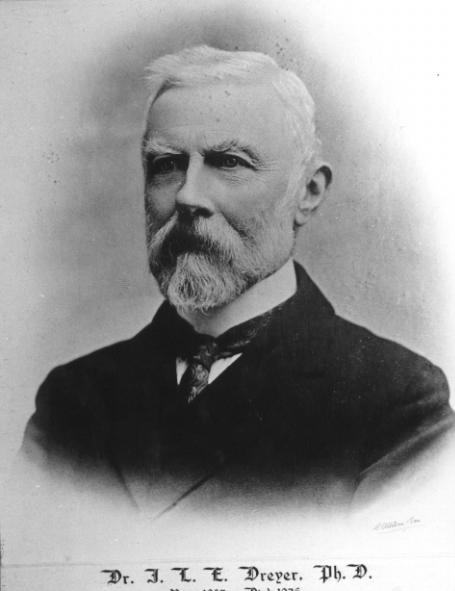 |
| "John Dreyer" by Unknown Licensed under Public Domain via Commons |
The New General Catalogue of Nebulae and Clusters of Stars (abbreviated as NGC) is a well-known catalogue of deep-sky objects in astronomy compiled by John Louis Emil Dreyer in 1888, as a new version of John Herschel's Catalogue of Nebulae and Clusters of Stars.
The NGC contains 7,840 objects, known as the NGC objects. It is one of the largest comprehensive catalogues, as it includes all types of deep space objects and is not confined to, for example, galaxies.
Dreyer published two supplements to the NGC, known as the Index Catalogues (abbreviated as IC). The first was published in 1895 and contained 1,520 objects, while the second was published in 1908 and contained 3,866 objects, for a total of 5,386 IC objects.
Objects in the sky of the southern hemisphere are catalogued somewhat less thoroughly, but many were observed by John Herschel or James Dunlop.
The NGC had many errors, but a serious if not complete attempt to eliminate them has been initiated by the NGC/IC Project in 1993, after partial attempts with the Revised New General Catalogue (RNGC) by Jack W. Sulentic and William G. Tifft in 1973, and NGC2000.0 by Roger W. Sinnott in 1988.
The Revised New General Catalogue and Index Catalogue was compiled in 2009 by Wolfgang Steinicke.
Wikipedia
John Dreyer
John Louis Emil Dreyer (1852 – 1926) was a Danish-Irish astronomer.
During 1878 he moved to Dunsink, the site of the Trinity College Observatory of Dublin University to work for Robert Stawell Ball.
In 1882 he relocated again, this time to Armagh Observatory, where he served as Director until his retirement in 1916.
In 1885 he became a British citizen. In 1916 he and his wife Kate moved to Oxford where Dreyer worked on his 15 volume edition of the works of Tycho Brahe, the last volume of which was published after his death.
He won the Gold Medal of the Royal Astronomical Society in 1916 and served as the society's president from 1923 until 1925.
History of the Planetary Systems from Thales to Kepler (1905), his survey of the history of astronomy, while dated in some respects, is still a good introduction to the subject. It is currently printed with the title A History of Astronomy from Thales to Kepler (available on-line).
A crater on the far side of the Moon is named after him.
Wikipedia
No comments:
Post a Comment